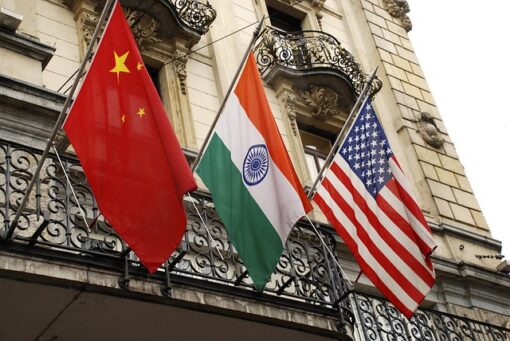The Five Superpowers Ruling the World in 2050
An exploration of the five superpowers that will dominate the world in 2050
Introduction
The year 2050 holds immense significance for global economic and political dynamics. As we project into the future, the notion of superpowers takes center stage, with certain nations poised to exert significant influence on the world stage. In this article, we delve into the future of superpowers, examining the five primary contenders for global dominance in 2050. Drawing from reputable sources such as the BBC, IMF, and NBER, we explore the potential trajectories of the United States, China, India, the European Union, and the African Union. Join us on this journey as we unveil the future superpowers and their implications for the world.
United States
The United States currently stands as a dominant global superpower, shaping political, economic, and cultural landscapes. Looking ahead to 2050, predictions based on reputable sources indicate the United States will maintain a prominent position. However, various factors may influence its trajectory. The nation’s technological advancements, economic strength, and military capabilities contribute to its potential dominance. Yet, challenges such as shifting demographics and emerging powers necessitate careful examination of the United States’ future status.
China
China’s rise as a major global power has been a subject of intense scrutiny. Presently, it asserts its influence across multiple spheres, challenging the United States’ supremacy. Projections suggest China will continue its ascent, potentially surpassing the United States by 2050. With a burgeoning economy, technological advancements, and geopolitical strategies, China exhibits the potential to shape the world order. However, the nation faces challenges related to socio-political factors, human rights concerns, and regional dynamics that could shape its future trajectory.
India
India, with its vast population and rapidly growing economy, is often touted as a future superpower. While it currently faces numerous challenges, projections highlight its potential to become a significant player by 2050. India’s economic growth, technological innovation, and soft power projection contribute to its prospects. However, obstacles such as poverty, infrastructure gaps, and geopolitical complexities require careful consideration when envisioning India’s journey to superpower status.
European Union
The European Union, as a collective entity, exhibits considerable influence in global affairs. However, the projection of its future standing remains uncertain. By 2050, the EU may experience shifts in its political and economic dynamics. Factors such as Brexit, regional tensions, and the rise of other superpowers may impact its ability to maintain or enhance its global influence. Cooperation and integration within the EU will play a crucial role in shaping its future position.
African Union
The African Union emerges as a potential superpower, driven by its vast resources, demographic advantage, and increasing economic growth. While Africa faces significant challenges, projections indicate its potential to transform by 2050. By addressing issues such as governance, infrastructure, and regional cooperation, African nations can strive towards attaining superpower status. External factors, such as international partnerships and investments, will also play a pivotal role in shaping Africa’s journey.
Implications and Interactions
The interactions and collaborations among the superpowers will significantly impact global governance and geopolitics. Power dynamics between the United States, China, India, the European Union, and the African Union will shape the international order. The competition for resources, influence, and technological advancements will drive strategic decision-making. Smaller nations and regions must navigate these changing dynamics to maximize opportunities and mitigate potential challenges.
Technology and Innovation
Technological advancements hold a key role in shaping superpower dynamics. As the five superpowers vie for dominance, emerging technologies will play a crucial role. From artificial intelligence and renewable energy to space exploration and quantum computing, the race for technological superiority will influence the trajectory of each superpower. Areas of cooperation and competition in technology will redefine global landscapes.
Economic Outlook and Trade
The economic projections for the five superpowers in 2050 reveal a shifting global order. While the United States, China, and India are poised for economic growth, the European Union may experience changes in its economic dynamics. These transformations will impact global trade patterns, potentially giving rise to new economic alliances and disrupting traditional networks. Smaller economies must adapt to these shifts and seize opportunities for sustainable growth.
Environmental Concerns
In the context of environmental challenges, the superpowers have a significant responsibility to address sustainability and climate change. As major carbon emitters and consumers of resources, their actions will shape the future of the planet. Efforts towards sustainable development, renewable energy, and climate change mitigation will determine their environmental credentials. Collaborative approaches to address global environmental issues will be crucial for long-term planetary well-being.
Cultural and Soft Power
Cultural influence and soft power play integral roles in superpower status. The United States, China, India, the European Union, and the African Union project their cultural identities and values globally. Through media, entertainment, education, and diplomacy, these superpowers shape narratives and perceptions. Cultural exchanges and intercultural understanding foster cooperation while promoting national interests. The battle for hearts and minds will continue to shape the world in 2050.
Security and Military Power
Military capabilities and security strategies have historically been crucial components of superpower status. The five superpowers invest heavily in defense and maintain advanced military technologies. The potential for an arms race and security concerns looms on the horizon. Balancing military prowess with diplomatic engagement and peacekeeping efforts will be critical to maintaining global peace and stability.
Social and Demographic Factors
Social and demographic changes exert significant influence on superpower dynamics. Population growth, aging societies, and migration patterns impact economic productivity, social stability, and geopolitical influence. Understanding these factors and their implications is vital to comprehending the future trajectories of the superpowers. Addressing social inequality, fostering inclusive societies, and harnessing demographic dividends will shape their fortunes.
Conclusion
The year 2050 will witness a reshaping of global power dynamics, with the United States, China, India, the European Union, and the African Union emerging as potential superpowers. Each possesses unique strengths, challenges, and trajectories that will shape their influence on the world stage. Technology, economics, the environment, culture, security, and societal factors all play integral roles in determining their journeys. Smaller nations must adapt and navigate these shifting landscapes while seeking opportunities for cooperation and sustainable growth.
FAQs
- Q: How do the superpowers interact and collaborate in the global arena? A: The superpowers engage in diplomatic negotiations, economic partnerships, and multilateral institutions to pursue their interests and manage conflicts.
- Q: What are the implications of the superpowers’ rise for smaller nations? A: Smaller nations may experience opportunities for economic growth, increased trade, and investments, but they must also navigate potential challenges and power asymmetries.
- Q: Will the rise of these superpowers lead to a new Cold War? A: While competition exists among the superpowers, the global landscape is complex, and the possibility of a new Cold War is contingent upon multiple geopolitical factors.
- Q: How can technology shape the future of the superpowers? A: Technological advancements offer opportunities for economic growth, military capabilities, and societal advancements, shaping the superpowers’ trajectories.
- Q: What role does soft power play in the rise of superpowers? A: Soft power, including cultural influence and diplomacy, plays a significant role in shaping global perceptions, attracting alliances, and projecting national interests.
Source References:
- BBC – Five superpowers ruling the world in 2050
- IMF – World Economic Outlook, April 2023
- NBER – Superpower Entropy: A Framework for Sizing and Ranking Nations






For the reason that the admin of this site is working, no uncertainty very quickly it will be renowned, due to its quality contents.